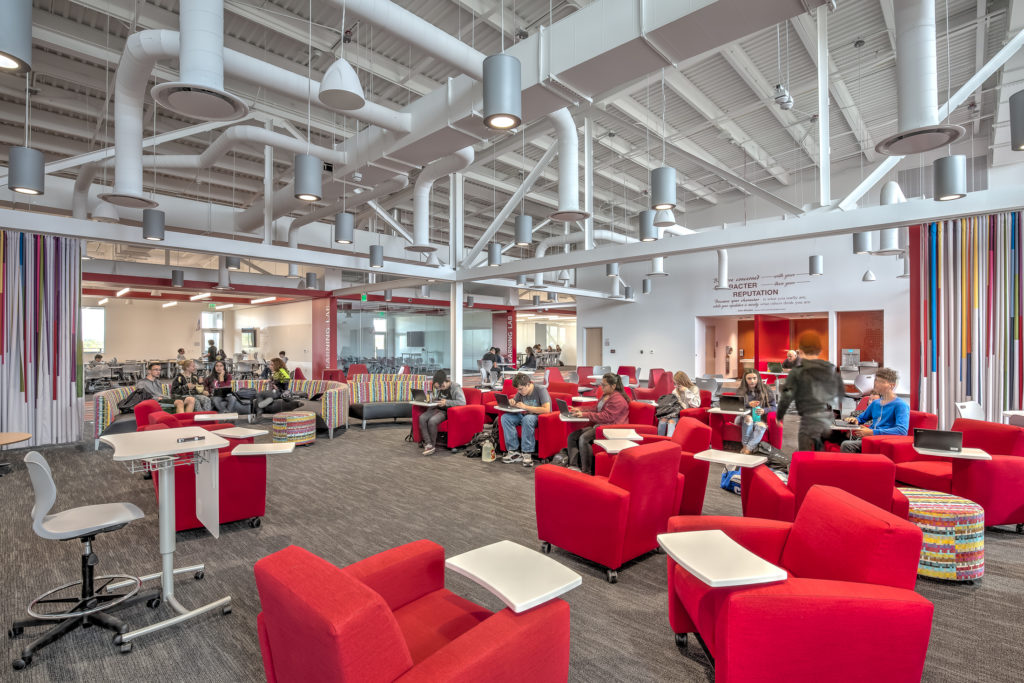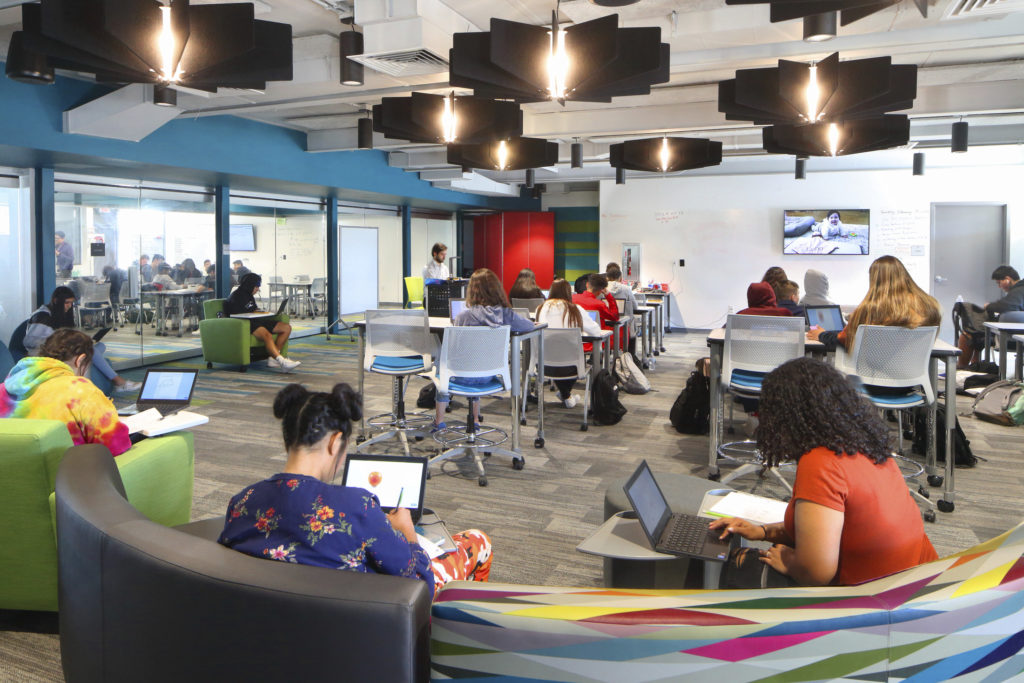When you close your eyes and envision a high school campus, what do you see? Do you picture students learning, performing, competing, and socializing? Or do you imagine international audiences attending conferences, professional development activities, and tours with institutions and corporations from around the world? At Canyon View High School in Waddell, Ariz., you experience these things and more, all reminders that the school is embracing its role as a catalyst for change in teaching and learning.
The story of Canyon View High School stems from one simple question posed by DLR Group during the initial planning meeting in 2015: are you here to replicate or innovate? Agua Fria Union High School District leaders, community members, business partners, teachers, and students responded with a resounding desire to innovate. While the list of accolades, awards, and recognition earned by Canyon View High School since opening in 2018 is extraordinary, what’s more impressive is the district and community’s initial and continuing commitment to take risks and create real changes to engage students and teachers in a meaningful way.

“The new facility enables innovation and measurable advancements in teaching and learning. These spaces allow teachers to advance their professional skills, and students to examine coursework more deeply to develop collaborative opportunity with peers globally,” said Superintendent Dr. Dennis Runyan.
Stakeholder Input
“As we looked at the landscape of education, we realized it was changing. We were very intentional about designing a high school experience for college and career readiness. This campus models the opportunity for students who are preparing for both worlds. So whether they are going straight into the workforce or whether they are going to college, this campus is designed to be supportive of their individual needs,” said Dr. Runyan.
Nearly 500 community members participated in an innovative approach to programming and design. Collaboration meetings included architects, engineers, community members, businesses, government agencies, district leadership, and students – all aiming to treat the project as a unique invention. District leaders also joined DLR Group designers on facility tours to observe collaborative team-based activity in some of the most forward-thinking educational and corporate facilities across the country.
At the conclusion of these meetings and tours, three bold ideas emerged that would shape the outcome of Canyon View High School:
A Call for Change
While the district sought to implement new pedagogies and an educational delivery model to transform student outcomes, institutional change was necessary to truly shift human behaviors in a new flexible physical environment. DLR Group introduced district leadership to B.O.L.D.™, a change management process that bridges organization, learning, and design. Through this process, DLR Group’s team guided campus leaders to define the desired outputs, including both teacher and learner profiles, that every Canyon View educator and student would develop over their tenure, essentially shaping the culture at this newly constructed school.

“Culture starts with vision, and the vision for this new school is student-centric learning that transfers ownership of the classroom to the collective school,” said Canyon View High School Principal Phillip Nowlin. “One reason our teachers and students interact so well is the design of the school. Teachers do not own their classroom. Rather, students determine the best delivery model for them and rearrange the space based on their needs.”
And despite the pressures resulting from COVID-19, the district continues to embrace a philosophy of teacher and student engagement in both remote and hybrid teaching and learning models.
Small Learning Communities Become Forts
The campus is comprised of four small learning communities that are a series of connected settings that can flexibly merge with one another to support various interdisciplinary learning activities. Two labs and a blend of six learning spaces are positioned around the perimeter of each SLC. Each SLC provides a variety of spaces that can change during the day depending on the specific activity to foster an environment conducive to relevant learning.
“Canyon View High School is built on collaboration and the opportunity for students to experience learning in a different way,” said Nowlin. “Our small learning communities are not only called forts, they also function as forts. Remember the forts you built as a child with blankets, chairs, and pillows that allowed your imagination to run wild? Here, we have walls that open, doors that slide, partitions that move and reshape a space, and mobile furniture that allows students to rearrange their environment to support their changing needs in the learning process.”
A Marketplace for Learning
Every aspect of Canyon View is flexible and adaptable, which results in greater utilization of all spaces. On a traditional campus, large volume spaces such as auditoriums, commons, and cafeterias are used approximately 20% of the day or week. The flexible nature of Canyon View reimagines these expansive areas and positions them as some of the most attractive and requested spaces on campus.

The building layout on campus forms an outdoor marketplace called the Agora where students gather and socialize. Leveraging the potential of the amazing Arizona environment, the Agora is designed as a micro-climate that allows for outdoor learning areas to be utilized 90% of the year. The central node of the Agora is the accelerator, an open-source incubator for the art of teaching and learning, evolved to further support the surrounding schools within the district, community, and nearby business partners.
“During the planning phase we explored the types of spaces used by corporate teams and adapted those concepts to the educational environment. A direct result of this discovery effort is the accelerator,” said Dr. Runyan. “It is programmed to support 137 activities and counting. These activities range from district-wide professional development, college fairs, theatrical productions, to student competitions and exhibits.”
The primary space in the accelerator is the theater, equipped with fixed seating and a retractable flat floor seating system at the back. The secondary space, designed to work independently or in tandem with the auditorium, is nicknamed the white box. Together the theater and white box can be used for conference events, professional development, and large-scale performances. In addition, a glass door opens to the outdoor learning stair, allowing the combined space to host crowds ranging from 250 to 1,500.The accelerator and adjacent spaces offer transparency, giving students and visitors alike a front row seat into the educational, community, and professional development activities on campus.
Bringing the Vision to Life
Siloed conversations around how kids learn and the best environments to develop necessary life skills have been occurring for years. On the contrary, Canyon View High School sets the precedent for what’s possible when forces unite to transcend traditional boundaries of teaching and learning to create the best possible environment for students and teachers. Learners at Canyon View High School are the beneficiary of district leaders willing to take a risk, a community supportive of a new way of teaching and learning, businesses partnering to provide real-life learning experiences, and a design firm delivering a solution that re-invents the educational experience.

Agua Fria 2.0
Lessons learned in the programming, design, and implementation of Canyon View High School have been applied to the phased renovation of the original Agua Fria High School, which celebrates a 50-year heritage. The same bold ideas applied to Canyon View High School were shaped by Agua Fria’s culture and context to create a new vision for the high school that supports multi-disciplinary small learning communities with specialty spaces focused on professional development for teachers. The design also provides hybrid break out spaces that allow for spaces for blended learning that support student-centric learning as a compliment to core curriculums.

